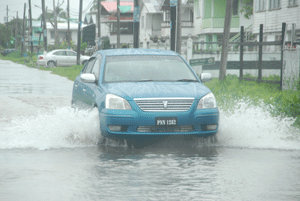THE jaw of a pontoon being used to temporarily prop up the Demerara Harbour Bridge (DHB) broke, at about 06:45 hrs yesterday, causing the western span of the flotation to sink into the river.  But DHB General Manager Rawlston Adams was quick to point out that the unfortunate sinking was not due to lack of maintenance. In fact, the pontoon sank approximately 26 hours after it had replaced one that is a permanent fixture.
But DHB General Manager Rawlston Adams was quick to point out that the unfortunate sinking was not due to lack of maintenance. In fact, the pontoon sank approximately 26 hours after it had replaced one that is a permanent fixture.
Speaking at a press conference in his office, some three hours after the incident, he said the flat-bottommed boat that went under water was installed on Sunday afternoon, just about 17:30 hrs, while one of the original hollow metal cylinders used to support the floating landing bridge was taken out to facilitate the removal of what is referred to as the ‘A’ frames.
He said the frames were corroded and needed to be changed, vehemently dispelling criticism that the occurrence was because they were not maintained.
Adams said it was through the regular and daily works and assessments that are carried out which alerted the responsible team to components that needed replacement.
He explained that, due to the replacing of the frames on the span between the numbers 60 and 61 pontoons, the engineers had to employ the use of two temporary platforms so that works could have been carried out.
OTHERS FOLLOWED
Adams said it was one of those that broke at the jaw, took in water and became submerged before the others followed.
He said had they not taken the steps to replace the frames, then the situation could have been worse and the bridge would have, sooner or later, developed the same problem but involving one of the regular floats.
Adams lamented that the two temporary floaters were the only ones being used to keep the bridge afloat at the time, because it is not customary for it to float on such, except in cases of repairs when the originals have to be removed completely or partly.
He said it was the intention of the workers to return to the area yesterday morning to continue their removal and replacement of the frames and men were working nearby when the collapse occurred.
Adams said the men noticed the bridge going down and immediately took the necessary action to clear it as is the standard operating procedure.
He, however, cautioned that the works were very much dependent on the tide and, as such, has to be done when it is low.
Adams said, once the pontoons can be resurfaced, then the spans on the bridge that went down will be brought to a level where the situation would be remedied.
He said it is suspected that the jaw on one of the unifloats that was assembled for the temporary pontoons broke and caused them to take in water.
A short time after the rupture, engineers began to pump the water out of the submerged pontoons so that they could be resurfaced.
Adams said the repairs would have taken the better part of yesterday and today and he hopes that, by later this afternoon, the bridge will be in a position to accommodate light and small vehicles.
Meanwhile, the bridge would be out of operation until the works are completed and it is deemed safe for use by vehicular traffic.
About the effect on ocean-going vessels, Adams said the mishap occurred after their scheduled passing, but some may be able to pass this morning.



.jpg)









